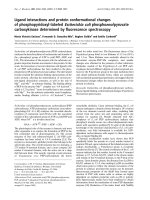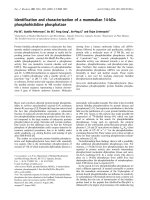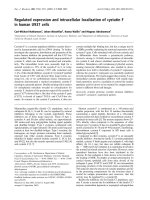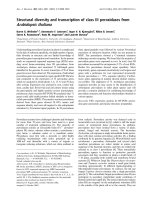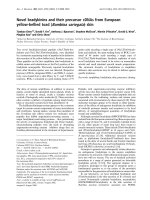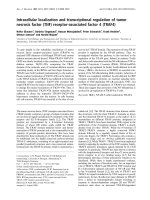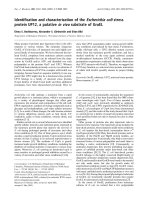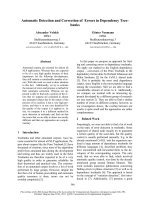Báo cáo y học: " Simultaneous detection and differentiation by multiplex real time RT-PCR of highly pathogenic avian influenza subtype H5N1 classic (clade 2.2.1 proper) and escape mutant (clade 2.2.1 variant) lineages in Egypt" potx
Bạn đang xem bản rút gọn của tài liệu. Xem và tải ngay bản đầy đủ của tài liệu tại đây (386.9 KB, 8 trang )
METH O D O LOG Y Open Access
Simultaneous detection and differentiation by
multiplex real time RT-PCR of highly pathogenic
avian influenza subtype H5N1 classic (clade 2.2.1
proper) and escape mutant (clade 2.2.1 variant)
lineages in Egypt
El-Sayed M Abdelwhab
1,2,3
, Ahmed M Erfan
2
, Christian Grund
1
, Mario Ziller
1
, Abdel-Satar Arafa
2
, Martin Beer
1
,
Mona M Aly
2
, Hafez M Hafez
3
, Timm C Harder
1*
Abstract
Background: The endemic status of highly pathogenic avian influenza virus (HPAIV) of subtype H5N1 in Egypt
continues to devastate the local poultry industry and poses a permanent threat for human health. Several
genetically and antigenically distinct H5N1 lineages co-circulate in Egypt: Strains of clade 2.2.1 proper replicate
mainly in backyard birds causing the bulk of human infections, while a variant lineage within 2.2.1 (2.2.1v) appears
to be perpetuated mainly in commercial poultry farms in Egypt. Viruses of the 2.2.1v lineage represent drift variants
escaping from conventional vaccine-induced immuni ty and some of these strains also escaped detection by
commercial real time reverse transcriptase PCR (RT-qPCR) protocols due to mismatches in the primers/probe
binding sites.
Results: We developed therefore a versatile, sensitive and lineage-specific multiplex RT-qPCR for detection and
typing of H5N1 viruses in Egypt. Analytical characterization was carried out using 50 Egyptian HPAIV H5N1 strains
isolated since 2006 and 45 other avian influenza viruses (AIV). A detection limit of 400 cRNA copies per ml sample
matrix was found. Higher diagnostic sensitivity of the multiplex assay in comparison to other generic H5 or M-gene
based RT-qPCR assays were found by examination of 63 swab samples from experimentally infected chickens and
50 AIV-positive swab samples from different host species in the field in Egypt.
Conclusions: The new multiplex RT-qPCR assay could be useful for rapid high-throughput monitoring for the
presence of HPAIV H5N1 in commercial poultry in Egypt. It may also aid in prospective epidemiological studies to
further delineate and better control spread of HPAIV H5N1 in Egypt.
Background
The incursion of highly pathogenic avian influenza virus
(HPAIV) of subtype H5N1 of phlyogenetic clade 2.2,
subclade 2.2.1 [1], into Egypt in 2005/2006 caused
severe economic losses in the commercial (previous
total annual p roduction of 850 million birds) and b ack-
yard sectors (250 million birds) of poultry production in
this country [2]. The virus also possesses considerable
zoonotic potential. Human cases of HPAIV H5N1 infec-
tion, characterized by a high fatality rate, started to
occur due to virus exposure of human s at the poultry-
human interface which is highly fissured in Egypt [3]. In
order to restore poultry production capacities and to
mitigate risks of an emergence of new virus variants
with increased pandemic potential in the human popula-
tion, efforts to control HPAIV H5N1 were given a high
priority [4].
Despite intense control measures including blanket
vaccination, surveillance and depopulation of infected
* Correspondence:
1
Friedrich-Loeffler-Institute, Greifswald-Insel Riems, Germany
Full list of author information is available at the end of the article
Abdelwhab et al. Virology Journal 2010, 7:260
/>© 2010 Abdelwhab et al; licensee BioMed Central Ltd. This is an Open Access article distrib uted under the terms of the Creative
Commons Attribution License ( es/by/2.0), which pe rmits unrestricted use, distribution, and
reproduction in any medium, provided the origi nal work is properly cited.
poultry holdings, HPAI H5N1 has gained endemic status
in Egyptian poultry populations [5] and continuous,
year-round circulation ofHPAIH5N1virushasbeen
reported [6-8]. This is at least in part due to the highly
divergent evolution of H5N1 viruses in Egypt which
seems to be accelerated and shaped by vaccine-induced
selection pressure leading to the emergence of geneti-
cally and antige nically distinct viruses [9]. Strains of the
parent subclade 2.2.1 proper (2.2.1p) are reported to cir-
culate nationwide mainly in unvaccinated birds, particu-
larly waterfowl from backyard holdings [7]. The vast
majority of human infections (34 fatalities out of 109
infected cases until 22
nd
June 2010 [1 0]) is attributable
to viruses of this group. Since 2007, viruses of a var-
iant sublineage emerged from clade 2.2.1. These
viruses, which will here be referred to as lineage 2.2.1v,
originated from and circulate predominantly in vacci-
nated commercial chickens [8]. These antigenically
drifted strains were shown to escape immunity induced
by standard H5 vaccination and are prevalent mainly
in Lower Egypt, particularly in the Nile Delta
[7,8,11,12]. Knowledge of the epidemiology, especially
the transmission pathways, of those two lineages
between commercial farms, backyard birds, feral birds
and humans i s incomplete but urgently required to
improve control measures. So far, assignment of
viruses to either lineage requires virus isolation and
antigenic characterization by hemagglutination inhibi-
tion or sequencing and molecular analysis. No rapid
typing tools are currently available.
A number of RT-qPCR assays for diagnosis and char-
acterization with respect to subtype and pathogenicity of
HPAIV H5N1 have been published. These assays target
the matrix gene [13,14] , the nucleoprotein gene [15,16],
the neuraminidase and the hemagglutinin [17-23]. Egypt’s
surveillance program embarked on the H5-specific
RT-qPCR assay [23], which is recommended by the
World Organization of Animal Health (OIE). The assay
was initially highly successful in detecting H5N1 infec-
tions in Egypt [5,7]. Since 2007, however, an increasing
number of strains in Egypt escaping detection by this
assay was reported [24]. Therefore, the aim of this study
was to develop a sensitive multiplex RT-qPCR ab le to
detect all HPAIV H5N1 variants of clade 2.2 currently
circulating in Egypt and, simultaneously, to distinguish
between conventional 2.2.1p strains and the 2.2.1v line-
age of vaccine-driven escape variants.
Results
A multiplex RT-qPCR assay was designed to de tect
HPAIV H5N1 viruses and simultaneously differentiate
the main two major lineages circulating in Egypt; classic
2.2.1p viruses and the newly evolving clade 2.2.1v of
antigenically drifted variant viruses. A single reaction
assay using multiplexed primers and probes (three col-
ours) was developed. Analytical characterization of the
assay was carried out using 50 Egyptian HPAIV H5N1
strains and other a vian pathogens. Diagnostic perfor-
mance was examined with 63 swab samples from
experimentally infected chick ens and 50 av ian influenza
virus (AIV)-positive swab samples obtained from differ-
ent host species in the field in Egypt.
Real-Time RT-PCR optimization
Two strategies were combined to sensitively detect and
distinguish viruses of clade 2.2.1p from 2.2.1v escape
strains (Figure 1). Lineage-specific primers had disparate
nucleotides at their most 3’-positions whereas lineage
specific-probes were distinguished by two nucleotide
positions towards the centre o f the probe. Locked
nucleotide chemistry was used to further increase the
specificity of certain probes. Optimization runs were
carried out using log
10
dilution series of RNA extracted
from A/chicken/Egypt/0879-NLQP/2008 (clade 2.2.1v),
A/chicken/Egypt/NLQP-0918Q/2009 (clade 2.2.1p) and
A/Whooper s wan/Germany/R65/2006 (Eur opean clade 2.2)
(data not shown). The conc entration of primers and
probes was optimized to increase the efficiency and sen-
sitivity of amplification to final values shown in table 1.
ThelowestCtvaluesandhighestΔR
n
values for the
multiplex RT-qPCR were o bserved using the foll owing
thermoprofile and the SuperScript III RT/Platinum Taq
Mix chemistry: 30 min at 50°C and 2 min at 94°C, then
42 cycles of 94°C, 56°C and 68°C for 30 seconds each.
No significant differences in sensitivity were evident
when running the three RT-qPCRs separately indicating
that the multiplex approach produced no relevant detri-
mental effects on amplification efficacy (data not
shown).
Analytical characteristics
The current protocol was found to have a detection
limit of approximately 2 - 5 RNA copies/reaction which
amounts to 400 - 1000 copies per ml sample matrix
when using cRNA as a copy-based standard. The dynamic
ranges of target detection are summarized in figure 2.
A total of 50 HPAIV H5N1 isolates from Egypt obtained
between 2006 and 2010 for which nucleotide sequences of
the HA gene were available, wer e examined by the multi-
plex assay which assigned 33 of them to clade 2.2.1p
(HEX-positive) whereas 15 isolates reacted like 2.2.1v
strains (FAM-positive) (Additional file 1, Table S1). An
exactly similar clustering was achieved for these strains in
a phylogenetic analysis based on full length HA sequences
(7, 8 and Additional file 1, Table S1). In addition, two iso-
lates reacted positive for both 2.2.1p and 2.2.1v lineages.
All 50 isolates were also detected by the ROX probe of the
multiplex RT-qPCR (Additional f ile 1, Table S1). For 40
Abdelwhab et al. Virology Journal 2010, 7:260
/>Page 2 of 8
isolates a comparison with the generic H5 RT-qPCR vali-
dated by Slomka et al. [23] was performed showing mark-
edly lower Ct values, corresponding to a higher sensitivity,
for the ROX probe assay.
In addition, several, but not all, non-Egyptian H5
viruses could also be detected by the multiplex RT-qPCR
with equal or slightly lower sensitivity compared to the
generic H5 protocol described by Slomka et al. [23].
Negative results (no measurable Ct obtained [> > 40])
were generated with all non-H5 AI viruses as well as with
other avian viral or bacterial pathogens (Additional file 2,
Table S2).
Diagnostic performance
Swab samples (n = 63) originating from SPF chickens
which were experimentally infected with A/chicken/Egypt/
0879-NLQP/2008 (clade 2.2.1v) or A/chicken/Egypt/
NLQP-0918Q/2009 (clade 2.2.1p) were examined by the
multiplex RT-qPCR and compared to Ct values obtained
with an H5-specific assay described by Slomka et al. [23].
Results are shown in Additional file 3, Table S3, and Fig-
ure 3. Swabs collected from individual birds were selected
on basis of Ct values obtained by a generic M gene-tar-
geted RT-qPCR (14, not shown) so as to represent a wide
range of samples with low to high concentrations of AIV
RNA. Special emphasis was put on samples with Ct-values
around 35. The multiplex assay assigned the correct line-
age within clade 2.2.1 for all samples. One sample (#15,
Additional file 3, Table S3) yielded a weak false-positive
signal (Ct 39.03) in the 2.2.1v specific assay although the
sample came from a chicken that was infected by a 2.2.1p
proper virus. However, upon repeated RNA extraction and
Figure 1 Localization of primers and probes. Localization of primers and probes as mentioned in table 1 along the HA gene is depicted. Two
target regions (P1, P2) were chosen. Primers and probes were selected with specificity for the HA of Egyptian HPAIV H5N1 viruses either of
lineage 2.2.1p (proper) or 2.2.1v (variant). Triangles (2.2.1p) and squares (2.2.1v) distinguish nucleotide positions specific for either lineage.
Labelling of hydrolysis probes was with FAM (F, 2.2.1v), HEX (H, 2.2.1p) or ROX (2.2.1p+v).
Table 1 Oligonucleotide primers and probes designed for this study
No. Primers/probes Sequence 5’-3’ Conc.
1
(nM) Position
2
Amplificate size (bp)
1 P1FW_2.2.1p GAR TCA ATA GGA AYT TAC CAA ATA CTG 400 1615-1641
85
2 P1FW_2.2.1v GAA TCA ATA GGA ACT TAC CAA ATA CTA TC 800 1615-1643
3 P1RV_2.2.1 AGA CCA GCC ACC ATT GAT TGC 400 1699-1679
4 PRO1.1_2.2.1v FAM-ACA GTGGCA AGT TCC CT-BHQ-1 64 1654-1670
5 PRO1.2_2.2.1p HEX-ACA GTG GCG AGC TCC CTA GC-BHQ-1 64 1652-1675
6 P2FW_2.2.1p GGA TTC ACC ATC CRA ATG ATGC 1600 620-641
106
7 P2FW_2.2.1v GGG ATT CAC CAT CCA AAT GAT GA 1600 619-641
8 P2RV_2.2.1p CCG TTT ACC TTA GAT CTA GTA GCT ATT 1600 752-726
9 P2RV_2.2.1v CCG TTT ACC TTA GAT CTA GTR GCT ATC 1600 752-726
10 PRO2_2.2.1 ROX -TAC CTA TAT TTC CGT TGG GAC ATC AAC ACT AAA-BHQ-2 64 675-707
1
Nanomolar concentration of a 25 μl reaction.
2
Position relative to the initiating codon of A/chicken/Egypt/06541-NLQP/2006 (H5N1), GenBank accession no. EU3729 46.1.
Bold face nucleotides indicate mismatch positions between clade 2.2.1p proper and lineage 2.2.1v variant viruses. Italics indicate use of locked nucleic acid
nucleotides.
The specificity of primers and probes for either or both of the 2.2.1 lineages is indicated with their designation.
Abdelwhab et al. Virology Journal 2010, 7:260
/>Page 3 of 8
analysis of the sample, this false-positive reaction was not
reproducible which indicates a possible spill-over contami-
nation possibly during the previous extraction procedure.
No significant differences in Ct values were evident
between the 2.2.1p specifi c assay (HEX) of the mult iplex
RT-qPCR and the Slomka H5 RT-qPCRs (Fi gure 3a).
However, both the 2.2.1v specific assay (FAM) and the
newEgyptianH5.specificassay(ROX)ofthemultiplex
mixture were significantly more sensitive (p = 0,027 and p
≤ 0,001) than the generic H5 RT-qPCR (Figures 3b-c).
Oropharyngeal or cloacal swabs were also sampled in
commercial farms (n = 11) and backyard poultry hold-
ings (n = 39) in Egypt. A total of 50 samples pretested
by M-specific RT-qPC R [14] to be positive for AIV was
examined using t he H5 multiplex RT-qPCR assay and
the generic H5 protocol [23]. The multiplex RT-qPCR
found all 50 samples positive for subtype H5 (ROX).
Among them, 32 were assigned to clade 2.2.1p and
15 to lineage 2.2.1v (Additional file 4, Table S4, and
figure 4) while three s amples were positive for both.
Only 45 s ample s tested positive in the generic H5 RT-
qPCR using the original protocol by Slomka et al. [23],
and on average the Ct values produced with the newly
developed multiplex assay were significantly lower (p <
< 0,001) than those obtained in both the M and the H5
generic RT-qPCRs (Figures 4a-c).
Discussion
We report here the development of a multiplex RT-
qPCR assay for detection and differentiation of Egyptian
H5N1 HPAI viruses of clade 2.2.1 proper (p) and the
eme rging 2.2.1 lineage of viruses which escape standard
vaccine-induced immunity (designated here 2.2.1v). The
assay was shown to have a detection limit of 2-5 cRNA
copies per reaction. Based on a phylogenetic analysis of
50 isolates tested [7,8], the assay is fully specific with
regard to assigning the Egyptia n H5N1 isolates to either
phylogenetic cluster. No unspecific reactivity with either
Figure 2 Detection limi ts and amplificat ion efficiency. Detec tion limits and amplification efficien cy of the multi plex RT-qPCR for detect ion
and differentiation of clade 2.2.1p proper and 2.2.1v variant HPAIV H5N1 strains from Egypt using cRNA as a copy-based target. The standard
curves were established by up to five independent runs. Average Ct values and variations are plotted against the cRNA copy numbers.
Abdelwhab et al. Virology Journal 2010, 7:260
/>Page 4 of 8
Figure 3 Diagnostic performance characteristics (experimental infections). Diagnostic performance characteristics of a newly developed
H5-specific multiplex RT-qPCR for detection and differentiation of clade 2.2.1p proper and 2.2.1v variant HPAIV H5N1 strains from Egypt
compared to standard H5 RT-qPCR (Slomka et al. [20]). The analysis comprises swab samples obtained from SPF chickens after experimental
infection with A/chicken/Egypt/0879-NLQP/2008 (clade 2.2.1v, open triangles, n = 34 samples) or A/chicken/Egypt/NLQP-0918Q/2009 (clade
2.2.1p, black triangles, n = 29 samples). See Additional file 3, Table S3, for individual values. Grey dots represent samples in which both clades
were detected. X-axis: Ct-values obtained by the generic H5 RT-qPCR [20]. Y-axis: Ct-values generated by the specific component of the multiplex
RT-qPCR as indicated above each graph.
Figure 4 Diagnostic perf ormance characteristics (field samples). Diagnostic performa nce characteristics of a newly deve loped H5-specific
multiplex RT-qPCR for detection and differentiation of clade 2.2.1p proper (black triangles) and 2.2.1v variant HPAIV H5N1 strains (open triangles)
from Egypt compared to standard H5 RT-qPCR [20]. The analysis comprises 50 M-PCR positive field samples obtained within the frame of the
Egyptian poultry surveillance program from commercial poultry farms (n = 11) and backyard holdings (n = 39). See Additional file 4, Table S4, for
individual values. Grey dots represent samples in which both clades were detected. X-axis: Ct-values obtained by the generic H5 RT-qPCR [20].
Y-axis: Ct-values generated by the specific component of the multiplex RT-qPCR as indicated above each graph.
Abdelwhab et al. Virology Journal 2010, 7:260
/>Page 5 of 8
non-H5 AIV or other avian pathogens was evident.
However, the assay can not beusedforgenericdetec-
tion of subt ype H5 viruses as a large percentage of non-
Egyptian H5 subtype strains could not be detected.
In terms of diagnostic p erformance regarding the
HPAIV H5N1 strains currently circulating in Egypt, the
multiplex assay was at least equal to standard RT-qPCRs
targeting the M gene of AIV and superior to a generic
H5 RT-qPCR [23] when examining swabs which
originated from experimental infections or from field
samples of poultry holdings in Egypt. The generic H5-
specific RT-qPCR assay described by Slomka et al. [23]
apparently missed five Egyptian field samples, possibly
due to mismat ches in binding regions of primers and/or
probes; one of the missed samples was assigned to line-
age 2.2.1v while four of them belonged to 2.2.1p. In
three field samples the multiplex assay detected both
clades with almost similar Ct values (Additional file 4,
Table S4, #9, #17, #18). The field samples analysed were
derived from pooled swabs of five birds of each holding;
as such it can not be excluded that infections with both
clades occurred simultaneously at these holdings. Work
is in progress to clarify these cases by sequencing clones
of HA gene fragments. A similar situation w as also
encountered with two isolates (Additional file 1, Table
S1, #3, #18); alignment of primer and probe sequences
with the published sequences of these isolates, however,
did not yield any hint for an unspecific reactivity. A
contamination of these isolates can only be excluded by
sequencing clones of HA gene fragments.
Reducing the amount of circulating HPAIV H5N1
virus by concerted actions of rapid and specific testing,
culling and vaccination of poultry is the key to mitigate
the risk of human infections and fatalities in E gypt.
Controlling the endemic HPAIV H5N1 situation in
Egypt is particularly painstaking because of [1] the con-
centration of the majority of commercial and backyard
poultry business in a very small part of the whole coun-
try (Nile valley and, particularly, Nile delta), [2] the
integration/contacts of backyard birds within small
commercial poultry farms (farms with 5.000-20.000
birds represent circa 75% of the poultry production), [3]
the marketing system (random uncontrolled movement
of birds to/from live bird markets), and [4] day
labourers at commercial farms usually raise backyard
birds in t heir houses. In addition, continuing viral evo-
lution which is even further accelerated and skewed by
vaccination pressure remains a daily challenge fo r diag-
nostic measures which are at the root of all efforts to
control the situation. Characterization of currently cir-
culating strains and, if required, adaptation of amplifica-
tion-based diagnostic tools, such as introduced here, is
essential to improve the situation.
Conclusions
The necessity to update commercial and generic
H5-specific RT-qPCRs for the Egyptian situation has
been stressed recently [24]. The current assay provides
this update. The assay is tailored to suite the special
Egyptian situation. Therefore, the multiplex assay is not
recommended for use elsewhere, particularly in areas
where n on-clade 2.2 HPAIV H5N1 are prevalent. Also,
should new lineages of HPAIV H5N1 be introduced
into Egypt, such as the 2.3.2 subclade viruses which
already escaped from Central and South-eastern Asia to
South-eastern Europe earlier in 2010, the current assay
will need updating again. In addition to detection of
clade 2.2.1p H5 HPAIV the multiplex assay also allows
the positive identification of the 2.2.1v lineage of vaccine
escape mutants. This lineage probably evolved in com-
mercial chicken farms where vaccination using standard
LPAIV H5 strains was practiced. Recent studies have
shown that new vaccines might be required to efficiently
induce protective immunity against lineage 2.2.1v viruses
in poultry [11]. The multiplex assay therefore may also
be instrumental in decision-making regarding the type
of vaccine to be used for the specific outbreak situation.
Methods
Reference viruses and bacteria
A panel of 50 HPAIV H5N1 strains isolated in SPF-
chicken eggs in the National Laboratory for Quality
Control on Poultry Production (NLQP) in Egypt was
used for determination of the analytical specificity and
sensitivity of the PCR assays (Additional file 1, Table S1).
In addition 42 further avian influenza viruses of sub-
types H1 [4], H2 [5], H5 [22], H6 [5], H7 [3], and H9
[3] from the repository of German National Reference
Laboratory for Avian Influenza, Friedrich-Loeffler
Institute, were analysed (Additional file 2, Table S2).
Non-orthomyx oviruses and several bacterial s pecies
were used to further determine the specificity of the
assay.
Primer/probe design
A collection o f 316 near full length H5 gene segment
sequences of H5N1 viruses circulating in Egypt between
2006 and 2010 was retrieved from the public GenBank
data base. Sequences were aligned using MUSCLE [25]
and manually edited. Primers and probes design were
selected from a variable region of the HA2 gene for detec-
tion of an 85 bp fragment and a more conserved region in
the HA1 gene region for detection of a 106 bp fragment
(Table 1, Figure 1). Primers P1FW-Standard-EGY, P1RV-
EGY and probe PRO1a-Standard-EGY were used for
detection of the clade 2.2.1p strains (HEX channel).
Primers P1FW-Variant-EGY, P1RV-EGY and probe
Abdelwhab et al. Virology Journal 2010, 7:260
/>Page 6 of 8
PRO-Variant-EGY (FAM channel) were used for detection
of the clade 2.2.1v variant s trains. Primers P2FW-Stan-
dard-EGY, P2FW-Variant-EGY, P2RV-Standard-EGY and
P2RV-Variant-EGY and probe PRO2-EGY were used for
detection of both lineages via the ROX channel.
Real time RT-PCR optimization
The concentration of primers and probes was opti-
mized in separate PCRs (two primers, one probe) and
re-adjusted when com bined in the multiplex RT-qPCR
to increase the effic iency of amplification. Likewise,
different annealing temperatures ranging from 50 to
60°C and differe nt chemistries (SuperScript III One-
Step RT-PCR system with Platinum Ta q DNA poly-
merase [Invitrogen]; Quantitect One step kit; [Qiagen])
were evaluated. Reactions were carried out in a 25-μl
volume on an MX3005P real time PCR machine
(Stratagene).
Quantitative analysis
For preparation of standard controls, the cloned H5
gene segment from A/chicken/Egypt/0879-NLQP/2008
(clade 2.2.1v) and A/chicken/Egypt/NLQP-0918Q/2009
(clade 2.2.1p) was used for generating cRNA in vitro by
run-off transcriptions performed as previously described
[18]. Detection limit of the RT-qPCR was determined
using 10-fold serial dilutions (10
1
-10
7
copies) of cRNA.
Samples from experimentally infected chickens
All animal experiments were conducted following offi-
cial German animal welfare regulations (LALLF M-V/
TSD/7221.3-2.1-031/09). Six weeks old SPF chickens (n =
10, each) were infected by the oculo-nasal route with a
dose of 10
6.0
TCID
50
of A/chicken/Egypt/0879-NLQP/
2008 (clade 2.2.1v) or A/chicken/Egypt/NLQP-0918Q/
2009 (clade 2.2.1p) (Grund et al., unpublished). RNA was
extracted from mixed oropharyngeal and cloacal swabs
collected from individual birds 2 or 7 day s post infection
(dpi). RNA was used in quantitative RT-qPCRs described
in this study and compared to M and H5 based RT-qPCR
assays as previously described [14,23].
Field samples
Tracheal and cloacal swabs were collected both from
poultry at co mmercial farms (n = 11) and backyard
holdings (n = 39) in the frame of the national surveil-
lance scheme in poultry sectors in Egypt from 2008 to
2010. Oropharyngeal and cloacal swabs from f ive birds
were pooled for RNA extraction and PCR analysis.
Nucleic acid extraction
Extraction of RNA from 140 μlofallantoicfluid(RNA
viral isolates) or swab fluid (field samples, experimental
infections) was carried out using the QIAamp viral RNA
mini kit (Qiagen, Hilden, Germany) following the manu-
facturer’ s instructions. The RNA was eluted from the
columns with 50 μl of DEPC-treated water and used
immediately or after storage at -80°C. Likewise, DNA
was extracted from bacterial species and DNA viruses
(Additional file 2, Table S2) using the QIAamp DNA
mini kit (Qiagen, Hilden, Germany).
Statistics
In addition to the descriptive evaluation of the test
results, the technical sensitivity of the new multiplex
RT-qPCR was i nvestigated by comparing positive Ct-
values with those of the standard H5-specific RT-qPCR
test recommended by Slomka et al. [23]. For this pur-
pose, Fisher’s exact tests were app lied considering the
one-sided hypothesis of achieving lower Ct-values by
the multiplex RT-qPCR than by the standard test. All
statistical calculations have been performed using R,
Version 2.8.1 (2008-12-22) [26].
Additional material
Additional file 1: Detection and differentiation of HPAIV H5N1
isolates collected from commercial poultry and backyard birds in
Egypt in 2006- 2010 by multiplex H5 RT-qPCR and a generic H5-
specific RT-qPCR [20].
Additional file 2: Analytical specificity of the multiplex RT-qPCR for
Egyptian HPAIV H5N1 using different avian influenza virus isolates
and other avian pathogens.
Additional file 3: Detection and differentiation of HPAIV H5N1 in
selected swab samples collected from SPF chickens experimentally
infected with Egyptian clade 2.2.1p proper or 2.2.1v variant HPAI
H5N1 virus strains by multiplex H5 RT-qPCR compared to a
standard generic H5 RT-qPCR protocol.
Additional file 4: Detection and differentiation of HPAIV H5N1 in
pooled swab samples collected from commercial poultry and
backyard birds in Egypt in 2008- 2010 by multiplex H5 RT-qPCR
compared to standard generic H5 and M gene RT-qPCR protocols.
List of abbreviations
AIV: avian influenza virus; DPI: days post infection; FLI: Friedrich-Loeffler-
Institute; HPAI: highly pathogenic avian influenza; LPAIV: avian influenza virus
of low pathogenicity; HA: hemagglutinin; NLQP: National Laboratory for
Quality Control on Poultry Production; O.I.E.: World Organization for Animal
Health; RT-qPCR: real time reverse transcriptase polymerase chain reaction.
Competing interests
The authors declare that they have no competing interests.
Authors’ contributions
ESAW carried out part of the development studies, the analytical and the
diagnostic evaluation; he performed the sequence alignments and helped to
draft the manuscript. AME and ASA carried out parts of the analytical and
diagnostic evaluation using Egyptian samples. MZ carried out the statistical
tests. CG, MMA and HMH provided samples for analysis, participated in the
design of the study and helped to draft the manuscript. TCH conceived and
coordinated the study, and drafted the manuscript. All authors read and
approved the final manuscript.
Abdelwhab et al. Virology Journal 2010, 7:260
/>Page 7 of 8
Acknowledgements
We are grateful to our co-workers and colleagues for excellent technical
work in the FLI, Germany, and the NLQP, Egypt. El-Sayed is funded by a
grant from the German Academic Exchange Service to the Free University of
Berlin. Work by the authors on Egyptian HPAIV H5N1 is co-funded in the
frame of an O.I.E. Twinning project between the Animal Health Research
Institute, Giza, and the FLI, Riems.
Author details
1
Friedrich-Loeffler-Institute, Greifswald-Insel Riems, Germany.
2
Animal Health
Research Institute, Dokki, Giza, Egypt.
3
Institute of Poultry Diseases, Free
University, Berlin, Germany.
Received: 30 August 2010 Accepted: 7 October 2010
Published: 7 October 2010
References
1. WHO/OIE/FAO H5N1 Evolution Working Group: Continuing progress
towards a unified nomenclature for the highly pathogenic H5N1 avian
influenza viruses: divergence of clade 2.2 viruses. Influenza Other Respi
Viruses 2009, 3:59-62.
2. Meleigy M: Egypt battles with avian influenza. Lancet 2007, 370:553-554.
3. Fasina FO, Ifende VI, Ajibade AA: Avian influenza A(H5N1) in humans:
lessons from Egypt. Euro Surveill 2009, 15(4) [osurveillance.
org/ViewArticle.aspx?ArticleId = 19473], pii = 19473.
4. Peiris JS, de Jong MD, Guan Y: Avian influenza virus (H5N1): a threat to
human health. Clinical Microbiol Rev 2007, 20:243-267.
5. Aly MM, Arafa A, Hassan MK: Epidemiological findings of outbreaks of
disease caused by highly pathogenic H5N1 avian influenza virus in
poultry in Egypt during 2006. Avian Dis 2008, 52:269-277.
6. Abdelwhab EM, Selim A, Arafa A, Galal S, Kilany WH, Hassan MK, Aly MM,
Hafez HM: Circulation of avian influenza H5N1 in live bird markets in
Egypt. Avian Dis 2010, 54:911-914.
7. Arafa A, Suarez DL, Hassan MK, Aly MM: Phylogenetic analysis of HA and
NA genes of HPAI-H5N1 Egyptian strains isolated from 2006 to 2008
indicates heterogeneity with multiple distinct sublineages. Avian Dis
2010, 54:345-349.
8. Balish AL, Davis T, Saad MD, El-Sayed N, Esmat H, Tjaden JA, Earhart KC,
Ahmed LE, Abd El-Halem M, Hakem M, Ali AM, Nassif SA, El-Ebiary EA,
Taha M, Aly MM, Arafa A, O’Neill E, Xiyan X, Cox NJ, Donis RO, Klimov AI:
Antigenic and genetic diversity of highly pathogenic avian influenza A
(H5N1) viruses isolated in Egypt. Avian Dis 2010, 54:329-334.
9. van den Berg T, Lambrecht B, Marché S, Steensels M, Van Borm S,
Bublot M: Influenza vaccines and vaccination strategies in birds. Comp
Immunol Microbiol Infect Dis 2008, 31:121-165.
10. WHO. 2010. World Health Organization: Situation updates–avian influenza.
[ />[cited 2010, June 13;].
11. Kim J, Kayali G, Walker D, Forrest HL, Ellebedy AH, Griffin YS, Rubrum A,
Bahgat MM, Kutkatd MA, Ali MAA, Aldridge JR, Negovetich NJ, Krauss S,
Webby RJ, Webster RG: Puzzling inefficiency of H5N1 influenza vaccines
in Egyptian poultry. Proc Natl Acad Sci 2010, 107:11044-9.
12. Terregino C, Toffan A, Cilloni F, Monne I, Bertoli E, Castellanos L, Amarin N,
Mancin M, Capua I: Evaluation of the protection induced by avian
influenza vaccines containing a 1994 Mexican H5N2 LPAI seed strain
against a 2008 Egyptian H5N1 HPAI virus belonging to clade 2.2.1 by
means of serological and in vivo tests. Avian Pathol 2010, 39:215-222.
13. Di Trani L, Bedini B, Donatelli I, Campitelli L, Chiappini B, De Marco MA,
Delogu M, Buonavoglia C, Vaccari GA: Sensitive one-step real-time PCR for
detection of avian influenza viruses using a MGB probe and an internal
positive control. BMC Infect Dis 2006, 6:87.
14. Spackman E, Senne DA, Myers TJ, Bulaga LL, Garber LP, Perdue ML,
Lohman K, Daum LT, Suarez DL: Development of a real-time reverse
transcriptase PCR assay for type A influenza virus and the avian H5 and
H7 haemagglutinin subtypes. J Clin Microbiol 2002, 40:3256-3260.
15. Muradrasoli S, Mohamed N, Belák S, Czifra G, Herrmann B, Berencsi G,
Blomberg J: Broadly targeted triplex real-time PCR detection of influenza
A, B and C viruses based on the nucleoprotein gene and a novel
“MegaBeacon” probe strategy. J Virol Methods 2010, 163:313-322.
16. Suarez DL, Das A, Ellis E: Review of rapid molecular diagnostic tools for
avian influenza virus. Avian Dis 2007, 51:201-208.
17. Chen W, He B, Li C, Zhang X, Wu W, Yin X, Fan B, Fan X, Wang J: Real-time
RT-PCR for H5N1 avian influenza A virus detection. J Med Microbiol 2007,
5:603-607.
18. Hoffman E, Stech J, Guan Y, Webster RG, Perez D: Universal primer set for
the full-length amplification of all influenza A viruses. Arch Virol 2001,
146:2275-2289.
19. Li PQ, Zhang J, Muller CP, Chen JX, Yang ZF, Zhang R, Li J, He YS:
Development of a multiplex real-time polymerase chain reaction for the
detection of influenza virus type A including H5 and H9 subtypes. Diagn
Microbiol Infect Dis 2008, 61:192-197.
20. Lu YY, Yan JY, Feng Y, Xu CP, Shi W, Mao HY: Rapid detection of H5 avian
influenza virus by TaqMan-MGB real-time RT-PCR. Lett Appl Microbiol
2008, 46:20-25.
21. Ng LF, Barr I, Nguyen I, Noor SM, Tan RS, Agathe LV, Gupta S, Khalil H,
To TL, Hassan SS, Ren EC: Specific detection of H5N1 avian influenza A
virus in field specimens by a one-step RT-PCR assay. BMC Infect Dis 2006,
6:40.
22. Payungporn S, Chutinimitkul S, Chaisingh A, Damrongwantanapokin D,
Buranathai C, Amonsin A, Theamboonlers A, Poovorawan YJ: Single step
multiplex real-time RT-PCR for H5N1 influenza A virus detection. J Virol
Methods 2006, 131:143-147.
23. Slomka MJ, Pavlidis T, Banks J, Shell W, McNally A, Essen S, Brown IH:
Validated H5 Eurasian real-time reverse transcriptase-polymerase chain
reaction and its application in H5N1 outbreaks in 2005-2006. Avian Dis
2007, 51:373-377.
24. Arafa A, Selim AA, Hassan MK, Aly MM: Genetic characterization of variant
strains of highly pathogenic avian influenza H5N1 that escaped
detection by real-time reverse transcriptase-PCR diagnostic tests. Avian
Dis 2010, 54:673-676.
25. Edgar RC: MUSCLE: multiple sequence alignment with high accuracy and
high throughput. Nucleic Acids Res 2004, 32:1792-1797.
26. R Development Core Team: R: A language and environment for statistical
computing. R Foundation for Statistical Computing, Vienna, Austria 2008
[], ISBN 3-900051-07-0.
doi:10.1186/1743-422X-7-260
Cite this article as: Abdelwhab et al .: Simultaneous detection and
differentiation by multiplex real time RT-PCR of highly pathogenic avian
influenza subtype H5N1 classic (clade 2.2.1 proper) and escape mutant
(clade 2.2.1 variant) lineages in Egypt. Virology Journal 2010 7:260.
Submit your next manuscript to BioMed Central
and take full advantage of:
• Convenient online submission
• Thorough peer review
• No space constraints or color figure charges
• Immediate publication on acceptance
• Inclusion in PubMed, CAS, Scopus and Google Scholar
• Research which is freely available for redistribution
Submit your manuscript at
www.biomedcentral.com/submit
Abdelwhab et al. Virology Journal 2010, 7:260
/>Page 8 of 8
